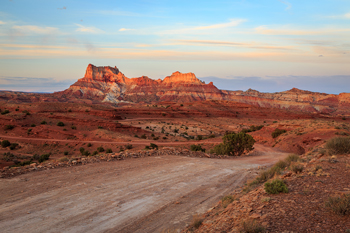SEMA News—August 2019
Congress Resorts to Old-School Lawmaking
An Inside Look at How a Massive Public Lands Bill Became Law
 An Ultra4 racer competes in King of the Hammers at the Johnson Valley Off-Highway Vehicle (OHV) Recreational Area, which was expanded by 11,000 acres under the new law. |
Those who say Congress never gets anything done and politicians are all talk and no action are frequently proven correct. The greatest obstacle to passing legislation in the 21st century in Washington, D.C., is the unwillingness to compromise. Every now and again, however, Congress comes together and embraces the philosophy of “a good compromise is when neither side is happy.”
Earlier this year, Congress passed a comprehensive public lands bill—the John D. Dingell, Jr. Conservation, Management and Recreation Act (S. 47), which contained more than 100 separate initiatives related to land use—and President Trump signed the bill into law in March. It reflected a delicate balance of providing recreational access to public lands, expanding wilderness protections, and authorizing federal lands to be transferred to state, local and private control to spur economic development in rural communities. The bill also designated six off-highway vehicle (OHV) areas in California while closing some trails to motorized recreation in Utah. It addressed priorities for a diverse group of public lands users.
Let’s take a deeper look at why compromise in Congress is so elusive and examine how this particular legislative sausage was made.
Our founding fathers intended for the legislative process to be deliberative and thoughtful, ensuring that public policies are well conceived. It’s hard to argue against that philosophy, although we now find ourselves in an era where Congress is unable to address even basic matters such as the country’s budget. The root cause of the stalemate is a fear that, by compromising, members of Congress will provide their political opponents with an opportunity to claim victory.
 While most existing OHV routes within the San Rafael Swell Recreation Area in Emery County, Utah, were protected in the new law, several trails were lost. |
Democrats and republicans alike have a strong desire to enact policies that are embraced by their supporters while making sure that the other side doesn’t chalk up too many victories. However, that philosophy wasn’t always pursued to the extent it is now, and compromise didn’t always have a negative connotation.
Considering the current dynamics, it was encouraging to see lawmakers return to a more old-school style of lawmaking, as members recognized that there was enough for their constituents to gain to make it worthwhile to accept provisions of the land-use bill that they didn’t fully support.
While S. 47 became law in early 2019—just two months into the new session of Congress—the bill was actually a combination of more than 120 different bills that had received scores of committee hearings and thousands of hours of debate in recent years. Lawmakers frantically tried to package and pass the bill at the end of the 2017–2018 session of Congress, but the government shutdown and subsequent battle over funding the federal government overshadowed and ultimately doomed the effort.
The momentum from the previous Congress to enact the lands package continued in early 2019. It was an extraordinary moment of rare agreement in time of equally astonishing partisan rancor, with lawmakers from each party determined to secure passage of the bill.
U.S. Senator Lisa Murkowski (R-AK), chairman of the Senate Committee on Energy and Natural Resources, and U.S. Senator Maria Cantwell (D-WA) introduced S. 47 in January 2019. The bill was comprised of legislation sponsored by more than half of the members of the U.S. Senate during the previous session of Congress.
S. 47 passed the U.S. Senate by a 92 to 8 vote on February 12. Two weeks later, the House of Representatives passed the bill by a vote of 363 to 62. President Trump signed it into law on March 12.
This legislative sausage had all the ingredients needed to ensure passage with enough to make lawmakers happy or at least willing to look past portions they found objectionable.
There is an important lesson to be learned: It sometimes takes years to enact legislation, and a bill covering a single issue may lack enough support to ever get passed. Nevertheless, lawmakers periodically combine multiple bills into a single measure in order to create a winning package. It has happened many times in the past with land-use bills, and it will happen again in the future.
| Provisions in S. 47 |
S. 47 was problematic for the off-highway vehicle (OHV) community. It contained two major provisions to protect OHV roads and trails in California and Utah, but the latter provision allowed about 75 mi. of trails to be lost in Emery County, Utah, with more to potentially follow in the future.
|






